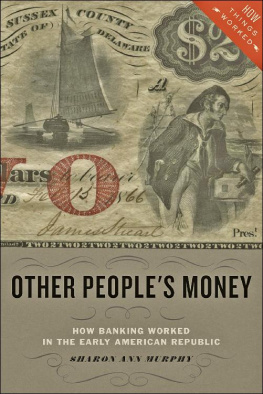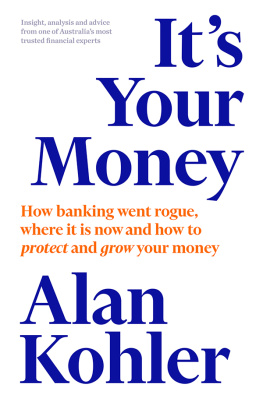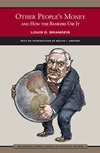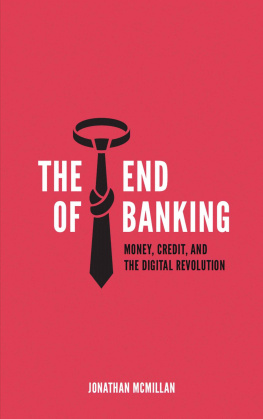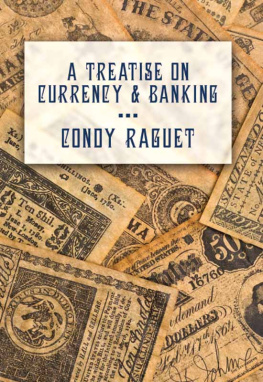OTHER PEOPLES MONEY
HOW THINGS WORKED
Robin Einhorn and Richard R. John, Series Editors
ALSO IN THE SERIES:
Sean Patrick Adams, Home Fires: How Americans Kept Warm in the Nineteenth Century
Ronald H. Bayor, Encountering Ellis Island: How European Immigrants Entered America
David B. Danbom, Sod Busting: How Families Made Farms on the Nineteenth-Century Plains
Bob Luke and John David Smith, Soldiering for Freedom: How the Union Army Recruited, Trained, and Deployed the U.S. Colored Troops
Phillip G. Payne, Crash! How the Economic Boom and Bust of the 1920s Worked
Other Peoples Money
HOW BANKING WORKED IN THE EARLY AMERICAN REPUBLIC

SHARON ANN MURPHY
PROVIDENCE COLLEGE
PROVIDENCE, RHODE ISLAND

2017 Johns Hopkins University Press
All rights reserved. Published 2017
Printed in the United States of America on acid-free paper
9 8 7 6 5 4 3 2 1
Johns Hopkins University Press
2715 North Charles Street
Baltimore, Maryland 21218-4363
www.press.jhu.edu
Library of Congress Cataloging-in-Publication Data
Names: Murphy, Sharon Ann, 1974 author.
Title: Other peoples money : how banking worked in the early American republic / Sharon Ann Murphy.
Description: Baltimore, Maryland : Johns Hopkins University Press, 2017. | Includes bibliographical references and index.
Identifiers: LCCN 2016017127 | ISBN 9781421421742 (hardcover : alk. paper) | ISBN 9781421421759 (pbk. : alk. paper) | ISBN 9781421421766 (electronic) | ISBN 1421421747 (hardcover : alk. paper) | ISBN 1421421755 (pbk. : alk. paper) | ISBN 1421421763 (electronic)
Subjects: LCSH: Banks and bankingUnited StatesHistory. | Banks and banking, AmericanHistory. | MoneyUnited StatesHistory. | United StatesHistory17831865.
Classification: LCC HG2472 .M87 2017 | DDC 332.10973/09034dc23
LC record available at https://lccn.loc.gov/2016017127
A catalog record for this book is available from the British Library.
Special discounts are available for bulk purchases of this book. For more information, please contact Special Sales at 410-516-6936 or specialsales@press.jhu.edu.
Johns Hopkins University Press uses environmentally friendly book materials, including recycled text paper that is composed of at least 30 percent post-consumer waste, whenever possible.
In memory of my dad,
Joseph B. Murphy (19422015),
the first banker in my life
and
Professor John A. James (19462014),
who first taught me the history of money and banking
The fetters which bind the people are forged from the peoples own gold.
Louis D. Brandeis, Other Peoples Money and How the Bankers Use It (1914)
ACKNOWLEDGMENTS
AFTER PUBLISHING MY FIRST BOOK with Johns Hopkins University Press, the editor, Bob Brugger, started asking me about my next project, which I vaguely said would be something on banking. He then told me about this new series they were publishing called How Things Worked, edited by Richard John (Columbia University School of Journalism) and Robin Einhorn (University of California at Berkeley). I immediately thought: If Richard and Robin are doing this project, I need to be in on it. My instincts were not wrong. Both have been incredibly supportive yet critical, pushing me to write an informative and (hopefully) useful book for the classroom environment. I couldnt have asked for better people to work with. (Drinks at conferences and dinner in Berlin were just icing on the cake!) Along the way, Bob Brugger retired, but Elizabeth Demers stepped in to shepherd the project expertly across the finish line.
My wonderful colleagues in colonial/early American history at Providence CollegeEdward Andrews, Patrick Breen, Steven Smith, and Adrian Weimerwere also incredibly supportive. In particular, Pat Breen read several early drafts of the first chapters. He challenged me to find the right voice and tone to reach my target audience of students. He also told me, on several occasions, Dont get it doneget it right. Whenever I was frustrated with the pace of my progress or with missing deadlines (many but not all of which were self-imposed), his words echoed in my subconscious like a scholarly Jiminy Cricket. In the later stages, Ted Andrews stepped in with some great suggestions for useful anecdotes and reviewed a more polished version of my first chapter. Most of this material is on topics I regularly discuss in my classes, so student feedback over the years helped to refine my explanations. I even asked my fall 2015 American Business History class to analyze my first three chapters. They took this assignment seriously and provided very thoughtful, helpful feedback. One student, Tegan Crean, read and critiqued the entire manuscript. Her insights were invaluable as I edited the final product. Many other scholars also read and commented on various portions of this book, including Jane Knodell, Tim Alborn, and Ed Perkins. Dan Feller and Dick Sylla graciously read the entire first draft, providing some critical corrections of my political and economic details.
The one person whose expert advice I really wanted but never received was economic historian John A. James, professor of economics at the University of Virginia. Right before I was ready to send him a full draft, I received word of his unexpected death. When I was an undergraduate at Virginia, John was the person who first taught me about the history of money and banking. He was also my mentor in the department of economics throughout my undergraduate and graduate years at Virginia, the yin to my history advisors yang. He was not only a gifted scholar and an amazing teacher and mentor but one of the nicest, most generous, most beloved people I ever knew. He would have loved the idea of this book. The only thing I can do to express my gratitude is to dedicate this book to him.
This book is also dedicated to my father. Someone once told me that your first major project is all about your parents. I initially intended to study banking, but my first book ended up being about a different financial intermediary: life insurance. But I have now returned to banking, and my dad was the first banker in my life. He started as a bank teller in the early 1960s and spent the next thirty-plus years working his way up through the organization, until he fell victim to the industry mergers and consolidations of the early 1990s. Before he was laid off, he was working in internal security, where he dealt with counterfeit and fraudulent currency and checks. As a kid, I loved when I got to go into the office with him and see what he did. This book was always going to be dedicated to him. But as I was editing the final draft, it quickly became apparent that he would not survive to see it in print. Although he passed away last fall, I know he is incredibly proud of everything I have done and continue to do. I miss you, Dad.
Finally, I need to thank my husband, Ken, and my kids, Amalia and Cono. While they didnt contribute directly to this project, I couldnt have done it without their constant love and support. And they are always a daily reminder that there are some things much more important than deadlines.
OTHER PEOPLES MONEY
PROLOGUE. How the Bank War Worked
ON JULY 4, 1832, from his sick bed in the White House, President Andrew Jackson declared: The bank, Mr. Van Buren, is trying to kill me, but I will kill it! Less than a week later, Jackson issued his famous veto of the recharter bill for the Second Bank of the United States, marking the height of the Bank War, which raged from 1828 to 1836. Far from a fever-induced rant, Jacksons statement accurately represented the passion that he and many others on both sides of the debate felt toward the Bank. His fury was real. His hatred was real. His fear of the institutions power was real. His determination to destroy the Bank was real.
Next page
